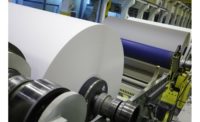A Year of Ups and Downs for the Packaging Industry

Image courtesy of BOBST
2021 created upheaval within the entire packaging industry. The shortage of skilled labor in some regions, on top of unprecedented price rises in paper, board and flexible substrates, has created unexpected challenges and uncertainties for many.
The price increase of source materials was tremendous. For instance, raw material used for machine frames and components increased unexpectedly as did hot rolled steel plate, which increased by 119% since January 2020. Cold rolled steel plate increased by 126%1. Structural section and beams increased by 91%. Aluminum alloy by 75% and copper by 65%1. Raw material usage for mechanical components (LLDPE Resins, nickel, polyurethan, etc.) increased by more than 40% since September 2020 and materials used for commercial parts (belt, chains, lubricants, rolls, etc.) increased on average by 9%1. Freight also increased since August 2020 — sea by 216%, air by 200% and road by 5%1.
Folding Carton and Corrugated Board
In 2021, the folding carton market continued with a steady growth driven by the pharma and food industry, a growing demand for more automatized production lines with enhanced quality control solutions and a migration of some commercial printers entering packaging production.
The corrugated board industry had a record year driven by global e-commerce growth, which has now expanded into new sectors such as food delivery. Large converters, and many others, decided to invest heavily in new equipment or green fields to answer this new demand. Converters are looking at more productive production lines with more automation and more in-line machinery enhanced with quality control systems.
Sustainability and environmental sensitivity are increasing, leading to an overall increased efficiency for new developments. Converters expect appropriate solutions, more flexibility in unpredictable times and more performance in a globally growing market. Inline machinery combined with quality control systems will be more in demand. Corrugated converters will boost the sustainable appeal of corrugated packages. The entire industry remains very optimistic looking ahead.
Labels and Flexible Packaging
Two words illustrate 2021 best for the labels and flexible packaging segment: Digitalization and Sustainability. Labels saw solid growth with All-in-One solution combining flexo and digital printing systems. Within digital, inkjet is making significant inroads with the highest growth rate as it delivers high quality combined with high productivity and low operating costs. However, the labels market remains a melting pot of different technologies, each of them best for specific applications. All converters are facing the rise in short runs and they all look for more automation, especially as manpower is more difficult to find. Substrates prices increased significantly, and some became more complex to source.
In flexible packaging, the entire market is facing the “plastic reinvention dilemma”. Recyclability and food compatibility are high priority topics, with strong demand for new high barrier and mono-material solutions or even paper metalized solutions. There is a strong demand driven by e-commerce home deliveries and in-home prepared foods. The highest growth rates are in stand-up pouches, flow wraps and single-serve packages. The industry is growing at a stable rate but cautious on how new regulations may impact plastic production.
In flexible packaging, the entire packaging industry is looking for a new “sustainable face”. There is some folding carton and glass production moving towards plastic for a lower environmental and transportation impact. At the same time, some flexible packaging is moving towards paper-based packaging. But the biggest trend is the move from multi-material packaging to mono-material solutions, although waste collection and recycling capacities are not solved yet. Bio plastic material and recycle film usage needs to ramp up to be competitive.
BOBST reports it is ready with mono-material solutions, and that the work done with partners like BASF, DOW, SUN CHEMICAL, ELBA, HOSOKAWA, ILENE, MICHELMANN and UFLEX and many more has enabled innovations that will shape the future of recyclable packaging.
On the topic of sustainability, BOBST received the ERA Gravure Award for Sustainable Packaging for its water-based printing rotogravure press.
Sustainability solutions have been deployed internationally. Sparsh Industries was the first company in India to deploy the new environmentally friendly solution AluBond on a wide web machine. Polibak in Turkey was the first to remotely install a BOBST K5 metallizer.
Looking ahead to 2022, digitalization will be the main driver for labels — converters will look for complete end-to-end digitalized solutions to optimize their production floor. All that can be digitalized, will be, enabling converters to deliver faster, with better quality and less waste, answering the growing demand for on-demand labels production.
In flexible packaging, BOBST expects the oneBARRIER solution to be available for a paper-based usage, leading towards more sustainability. Extended Color Gamut management solution — oneECG — will continue to make inroads into production sites, replacing ink mixing and related waste. Overall, the company believes that plastic packaging, well produced and well recycled, has a future and we are ready with commercially available solutions.
For 2022, BOBST expects to see an increase in the number of field service engineers, getting always more involved in the reactive and proactive support to our clients with remote assistance growing further. Quality control solutions will also gain in importance as the best way to reduce waste, reduce claims and increase profitability. The BOBST oneINSPECTION offering is part of the BOBST commitment to make zero-fault packaging a reality.
In Summary
2021 was strong, unpredictable and full of opportunities. The sustainability developments should be part of solutions, supporting all industries and particularly flexible packaging production, answering brand owners’ recyclability pledges. The pandemic continues to play an important role on people’s behaviors. By innovating, promoting the sustainability of our industry and its products, and always keeping in mind that our industry always follows cycles over periods of time — the packaging industry can succeed.
For more information, visit www.bobst.com.
1 BOBST procurement data
Looking for a reprint of this article?
From high-res PDFs to custom plaques, order your copy today!





